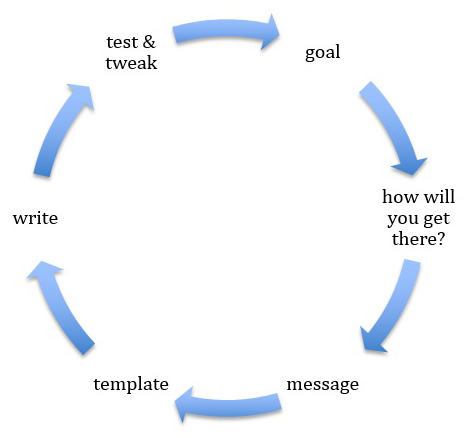How to write gourmet marketing
One of the biggest challenges business owners face when it comes to writing is this: they follow what I call a ‘fast food’ process.
Here’s what most self-employed professionals think the process is:
1) Sit down.
2) Write.
It’s a lot like going to the drive through, no?
(Sorry, my bad. Should be ‘drive-thru.’)
But just like the bag of food handed to you through the window of your car so you can eat French fries with your seat belt on, fast food copywriting often leads to quick salty satisfaction followed by regret and unhealth.
(Also: can we get real here for a second? I just ate two egg McMuffins and hashbrowns and French fries and an excellent cup of coffee at you-know-where last weekend. I’m no hater. But the other 364 days of the year, you’ll find me at Kale-oholics Anonymous).
There is no substitute to a home cooked meal, made with love.
Same thing goes for your marketing copy.
The problem with a fast food writing process is threefold:
1. It’s unrealistic
2. We tend to beat ourselves up for our writing ‘taking so long’
3. It tends to resonate with less-sophisticated customers with money or self-esteem issues (a.k.a. ‘fast food clients’)
The solution?
Cut yourself some slack and ditch the fast food process that’s something more ‘you’ – what I call the “Gourmet Writing Process.”
Here it is, in all its glory:
Step 1: Define your goal. If your writing project were perfectly executed, what would happen? For many business owners, this question alone will save you much wasted time and heartache. Common goals are: get 5 new 1-1 clients. Build my list. Sell my first group program online. Drum up initial sessions with my teleseminar. Get clear on what you want to have happen.
Step 2: How will you get there? Once you’ve got your goal, then you ask yourself, “what do I need to do to achieve that goal?” Here’s a hint – a lot of the time, it’s NOT writing. For example, if you want more 1-1 clients, typically you need to actually reach out and invite your leads to do an initial session with you.
There are writing project you can use to do this, like a simple 3 email sequence to your list inviting them to sessions. But 9 times out of 10, the shortest path is to actually ASK PEOPLE. This can be intimidating and fear-triggering, which is why a lot of business owners spend months “writing their website.” I’m not judging. I’m just saying.
Step 3: Craft your message. For your writing to resonate and sell, you need to know who your audience is and what they are looking for. Many business owners never bother to do this step, which is why their copy is boring and looks like everyone else’s. Oh, and doesn’t get people to act or buy. Let’s not forget that piece, either. There are actually 6 pieces of a moneymaking message, that I’ll cover in a separate article.
Step 4: Use a template. Templates are patterns you can use to give your writing project – whether it’s an Awesome Free Gift, teleseminar opt-in page, email campaign or website – a structure. When I take my clients through a writing process, I give them a template to follow. Not to limit them. But to show them the flow of ideas it takes to persuade readers to take action. Templates are everywhere; you can start a swipe file of your favorites (I keep my swipe file in Evernote; it’s a great free online service for web clippings and notes. Travel with an empty mind!). Best of all, using a template cuts your writing time in half. Or more.
Step 5: Write. Now that you’ve set yourself up for success, you write. There are a whole crop of obstacles, hobgoblins, and distractions that pop up at this stage, but at least you’re showing up armed with clarity and a solid strategy.
Step 6: Test & tweak. Get your project out there in the world, then listen. One of the biggest myths out there is that there are people who nail their message on the first try. The truth is, your message evolves over time. And it’s actually not about you guessing what your people want – it’s more of an experiment. Where you put your best guess out there, and then notice what resonates and what falls flat. This is the biggest difference I see between newer business owners – who pressure themselves to Find The Perfect Words – and successful business owners – who hone their instincts about what their audience wants by putting ideas out in the field and seeing what works (and what bombs).
I recently taught this process to a group of business owners who came to Montana to write with me. And after I presented, I asked them, “Where in this process do you tend to get hung up?” What’s interesting is that we all tend to have one or two steps that we tend to skip or get stuck in. That’s natural and totally normal. . . it just means you need to add a bit more attention to that phase of the process.
I’m curious – where in this process do you tend to get hung up? Post it – and any tips you’ve found that help you in your gourmet writing process – in the comments below.



2 Comments
Hey Stella, thanks for the post, I am a fast food writer, even though I do have to rewrite because every time I re read my writing words like “shit” comes out my mouth but there is a point that the message is sent albeit imperfectly. Tweaking is another weakness I own. It is obvious when I publish a piece I hate re reading it. Again, thanks for the article for me it was inspirational.
Tony,
I’m curious: what makes you a ‘fast food writer’?
/st